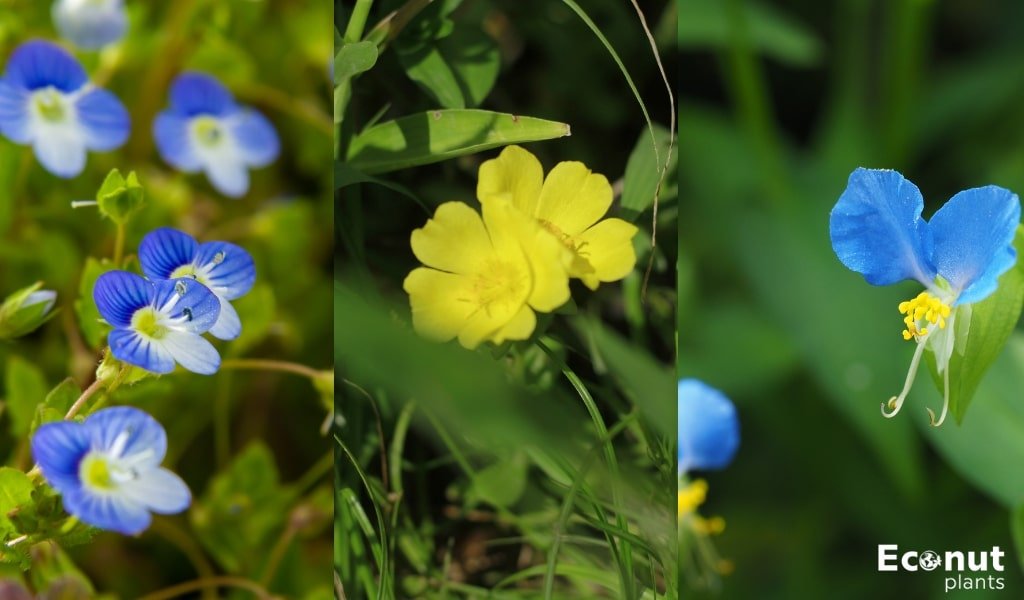Weeds can indeed cause gardeners to have issues with their plants. Even though certain weeds have a lovely appearance, they can also be invasive. Recognizing every kind of weed and keeping it from taking over your entire garden can be challenging.
Remember that many weeds are beneficial to pollinators, so you might want to leave them alone or move them to a different location. In this article, we examine the most common weeds with flowers to help you identify what stays and what needs to be relocated.
1. Chickweed
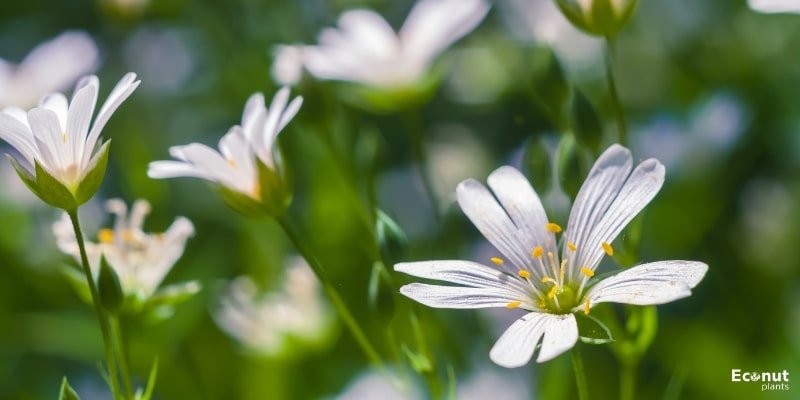
Scientific name: Stellaria media
A flowering annual weed is chickweed. In the early to mid-spring, it bears tiny white blooms. On the tips of each flower petal, there is a tiny, organic split. The diameter of the blossoms never becomes larger than one centimeter.
Its green ovary produces yellow, green, or red anthers, if you look attentively. Chickweed’s flower stalks are covered in a fine covering of hair, just like its stems. Partially shaded, damp soil is ideal for chickweed growth. This weed will probably start to grow under your shrubs or other tall vegetation if you’re not aiming to grow it.
As long as the soil retains moisture and has adequate drainage, it doesn’t care what kind of soil it grows in. In USDA zones 4 through 11, chickweed grows.
2. Daisy Weeds
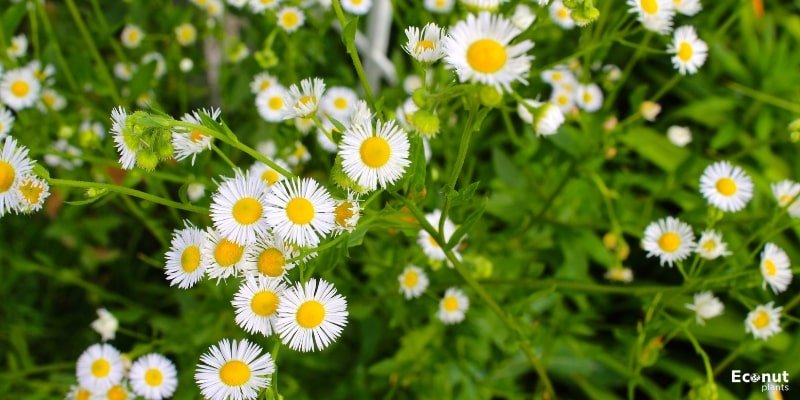
Scientific name: Bellis perennis
You’re exactly right if you imagine the daisy weed as having yellow pom-pom centers and brilliant white petals. Daisy blooms are weeds that spread widely, even though they look good where you want them to.
Their broad leaves can grow up to 2.5 inches long, and their blossoms have a diameter ranging from 1 to 1.5 inches. There are several tiny, inoffensive spikes on the tips of daisy weed leaves.
There are numerous locations where you can find wild daisy weeds, including garden walls, asphalt gaps, and rock crevices. In compacted soil, where other plants cannot flourish, they grow well. Daisy weeds choke out other plants by creating a dense mat, even in more fertile soil.
When daisy weeds grow best in full sun and moist soil, they spread quite quickly. USDA zones 4–8 are where they grow.
3. Goldenrod
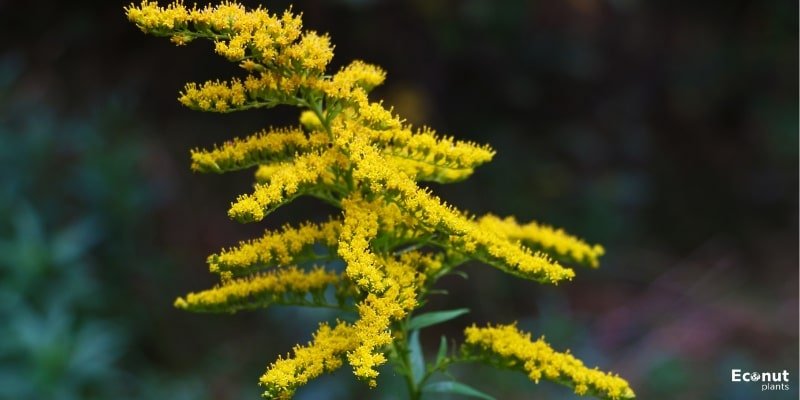
Scientific name: Solidago sp.
Goldenrods may make you sneeze, but after you’ve got them under control, they’re a great way to attract butterflies and bees to your garden so they can pollinate your crops.
The late summer and autumn seasons are when goldenrod flowers bloom. It has tall branches with vivid orange ends on little yellow flowers. Despite their lovely look, goldenrods are considered weeds due to their invasiveness and the fact that they typically lack blossoms for the majority of the year.
Goldenrods may find a place to call home almost anywhere. They don’t mind the kind of soil that they are in, and they can withstand protracted droughts in addition to eagerly soaking up water.
It’s a shame for your garden, but a cluster of goldenrods rarely gets destroyed by pests or illnesses. USDA zones 3–9 are where they grow.
4. Cat’s Ear
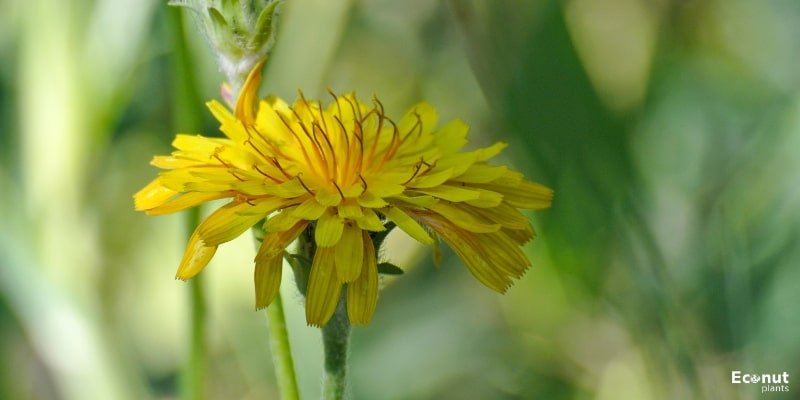
Scientific name: Hypochaeris radicata
The cat’s ear is distinguished by its vivid yellow blooms, which have multiple layers of petals and resemble a dandelion on a flatter surface. From May to September, the flowers bloom on slender, wiry stems. Their leaves feature microscopic hairs, and you can even eat them raw in salads.
Once a cat’s ear emerges in your garden or lawn, you can count on these perennials to properly distribute their seeds and come back each year. Since they like to grow in areas with grass, you should weed your garden frequently if you don’t want them there.
Cat’s ear thrives in moist conditions and tolerates salted soil rather well. As a result, they can grow near salt lakes and wetlands. The USDA zones 3a through 11 are ideal for the self-sowing cat ear.
5. Common Ragworts
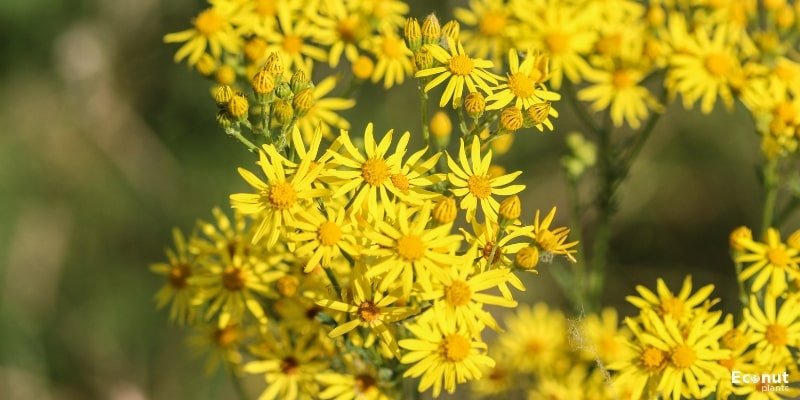
Scientific name: Jacobaea vulgaris, syn
The common ragwort is known for its vivid yellow blossoms. Beginning in mid-June and ending in November, they flower for the full summer and beyond. This plant has to have been exposed to cold temperatures to blossom.
Moreover, it might take up to three years for common ragwort to grow to a size large enough to produce flowers. Around 70 seeds are produced by each flower head, and a single plant can yield up to 150,000 seeds.
Since dunes are their natural home, common ragworts do well on sandy soil. The common ragwort will be happier in poorer soil because it will have less competition, but it can also be found in grasslands and low-nutrient soil.
Common ragwort can be found growing in USDA zones 4 through 8, and it doesn’t need a certain pH to be healthy.
6. Wild Multiflora Roses
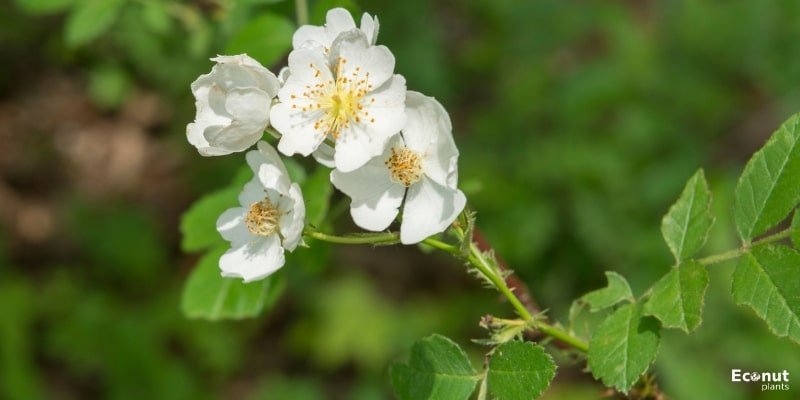
Scientific name: Rosa sp.
The article about weeds with blooms may not seem to fit wild roses; however, these roses lack the lovely, velvety cups you would offer your significant other. They have five petals instead, which spread out to form an almost flat surface.
That’s why the yellowish-white center of this bloom shows. Although the hues of wild rose petals vary, the majority have a pinkish-white blend. Similarly to contemporary (grafted) roses, they also have spines on their thick, woody stalks. Introduced from abroad, these plants are regarded as highly invasive.
While there is a kind of rose known as the swap rose that thrives in damp environments, wild roses prefer sunny spots with well-draining soil. Since airflow is essential to their health, illnesses can develop when they grow too close to one another.
Naturally, considering how difficult it may be to remove these plants’ woody bases, you might not want them to persist. USDA zones 3–8 are where wild roses thrive.
7. Rosebay Willow herb
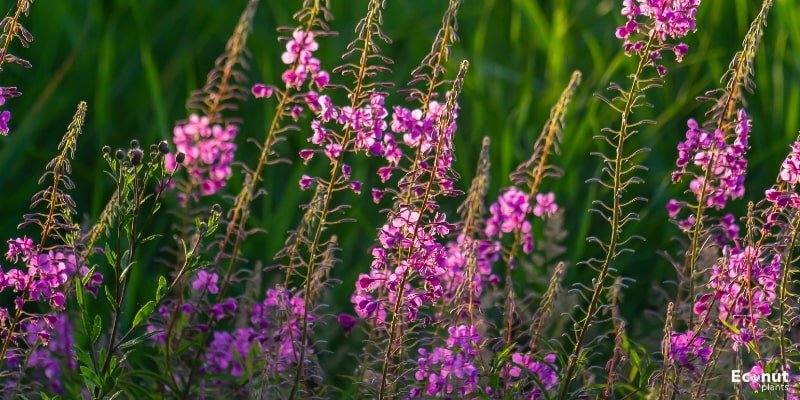
Scientific name: Chamaenerion angustifolium
The rosebay willowherb is not a willow in the traditional sense, but it is tall and wispy, with grassy leaves that can reach a height of 1.5 meters. From June to September, it has enticing pinkish-purple flowers.
Rosebay willowherbs are weeds because they spread swiftly over open areas, packing together densely to stifle competition from other plants. Their locations are on the boundaries of meadows, wasteland, and woodlands.
Sunlight and shade, as well as dry or damp soil, are necessary for rosebay willowherb’s leaves to develop in an upward spiral around their stem.
Rosebay willowherbs grow in a variety of soil types, including sandy, loamy, and clay. They also thrive in a range of soil pH conditions, from slightly acidic to slightly alkaline. USDA zones 3–7 are where they grow.
8. Pokeweed

Scientific name: Phytolacca Americana
While pokeweed is a plant with some medical uses, its red berries are what make it popular since they can be used to make red food colouring and ink. However, because it can reach a height of 10 feet, it’s probably not a plant you want surrounding your property.
Pokeweed has unusual-looking blossoms. Despite lacking actual petals, they produce pink racemes with blooms that are typically white to green in colour, all thanks to their five sepals. After that, the blossoms develop into purplish-black berries, which give rise to this plant with a recognizable appearance.
Pokeweed flourishes on the margins of forests and in fields because it favours sunny locations. In temperate regions, the blooms bloom from May to October; in warmer regions, they do so all year round.
Pokeweed will happily thrive in soil as low as 4.7 pH, which is unfortunate for individuals who have acidic soil. It grows in soils that are neutral to slightly alkaline and in zones 4 through 8.
9. Canada thistle
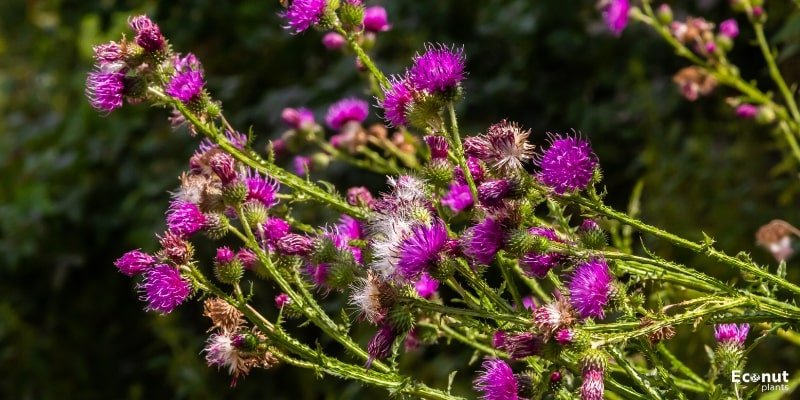
Scientific name: Cirsium arvense
A weed that grows outside of the Great White North is called Canada thistle. Because of its enormous root system, it is difficult for the normal individual to stop the plant from growing back. The purple flowers of this weed appear on the plant in late spring or early summer.
Each flowering stem contains 1,000–1,500 seeds, which are pollinated by insects attracted to the delicious scent of the blooms. The seeds of Canada thistle are remarkably resilient; they may tolerate being submerged in water and endure for up to 22 years underground before sprouting.
For growth and health, the Canada thistle requires cool, well-aerated soil and lots of sunlight. In regions with 17 to 35 inches of yearly precipitation, it is also found. It also requires a lot of rain.
One Canadian thistle plant can cover up to six diameters of space in two years under these circumstances. Grown in USDA zones 3a through 10b.
10. Bindweed
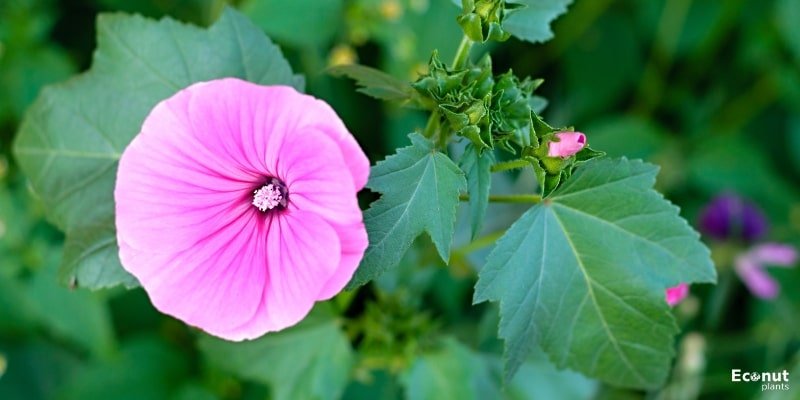
Scientific name: Convolvulus arvensis
Bindweed has trumpet-shaped, 2-inch white or pink flowers that mimic morning glories. The blossoms can occasionally have stripes of pink and white. Its flowers usually appear in the middle of summer and last until the autumn.
However, bindweed vines grow over wide spaces and up whatever object they come across before flowers appear. Their leaves resemble arrows, and they cling firmly to their hosts by encircling them with their slender vines.
If you would like to consciously plant bindweed, look for dried-out pods on a wild plant. Next, split open the pod and sow the seeds inside in the autumn.
The best places for bindweed to grow are around full-sun woodlands and hedgerows. Under perfect circumstances, this perennial climber can reach a height of more than six feet, and its USDA hardiness rating is 4–8.
11. Common Chickweed

Scientific name: Stellaria media
One of the numerous edible weeds on this list with blooms is the cold-loving common chickweed. Some of the small white flowers in them may not have any petals at all, whereas others have lobed petals. Usually, yellow or orange, three stamens, and three styles can be found in the center of the flowers.
Chickweed is an annual plant that thrives in cold areas. However, it turns into an evergreen perennial in warmer climates. Its delicate, easily broken stems can reach a maximum length of 16 inches.
Chickweed stems are covered in tiny, irregular hairs. Its oval leaves flow down the stalk in opposition to one another.
Chickweed grows best in damp soil that receives either full or partial shade. In less-than-ideal conditions, it will still flower, but it will do so at a reduced height. USDA zones 4–11 are where chickweed grows.
12. Dayflower
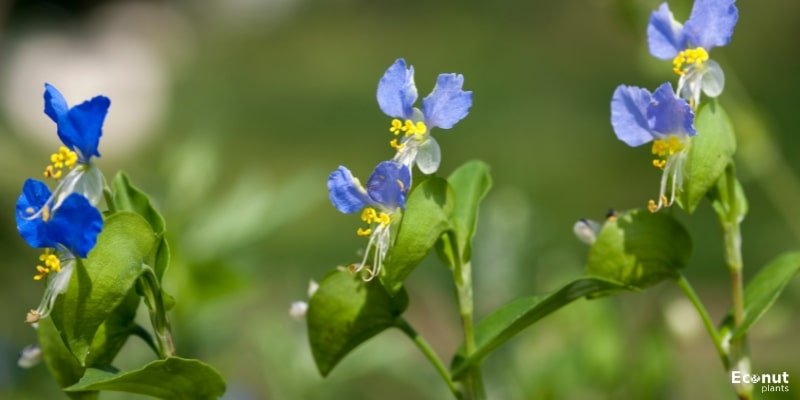
Scientific name: Commelina communis
The dayflower is a weed that grows intricately into a 1- to 2.5-inch-wide, periwinkle flower. It contains just three petals: one tiny white flower and two larger, periwinkle ones. However, it doesn’t stop there. The dayflower resembles an exotic tropical plant with its three long white sepals and five or six yellow stamens.
These flowers bloom from mid-summer to early autumn, lasting roughly one to two months. The dayflower has glossy, deep green leaves with a slight upward curl when it isn’t in bloom.
People consider dayflowers to be weeds because of their aggressive growth, despite their beauty. It prefers full or partial sun and loamy or fairly sandy soil.
People consider dayflowers to be weeds because of their aggressive growth, despite their beauty. It prefers full or partial sun and loamy or fairly sandy soil. To thrive, daylilies require water that is semi-wet. In USDA zones 5b through 8a, they grow.
13. Giant Hogweed

Scientific name: Lamium purpureum
Like Queen Anne’s lace, which we’ll discuss later, giant hogweed can reach heights of up to 15 feet instead of only 4 feet. A cluster of tiny white blooms makes a single flower with a slight upward tilt in it.
Each flower mass on the enormous hogweed can grow up to 60 centimeters in diameter, and it flowers in June and July. Oval-shaped, flat seeds replace the blossom in the autumn.
Big hogweed may draw attention, but you should never touch it naked. Should you accidentally get its sap in your eyes, it might result in blindness, burns, and scars.
Anything from ravines to creekbanks to forests can support the growth of giant hogweed. Any kind of soil that they can dig roots into is where they choose to live. USDA Zones 3a through 9b are where giant hogweed is found.
14. Hairy Bittercress
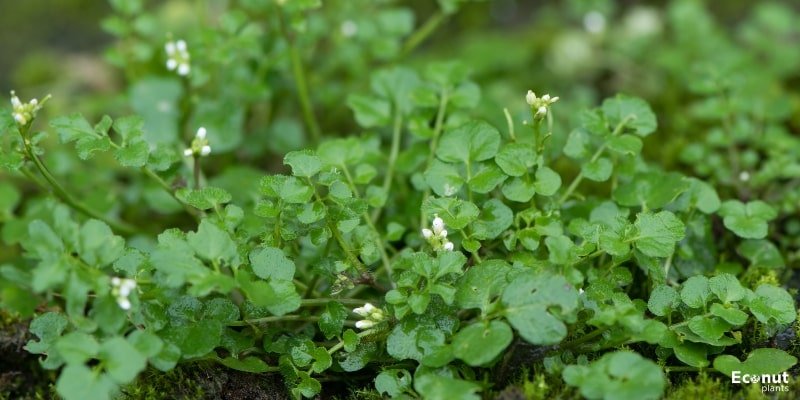
Scientific name: Cardamine hirsuta
The little white blooms that appear around the circular green leaves of hairy bittercresses are ground weeds that reveal their faces in April and May. Since they are members of the mustard family, as soon as their seeds sprout, they begin to develop quickly.
Speaking of seeds, the hair bittercress develops lengthy seedpods from its flowers as it approaches the end of its life cycle. When these seedpods dry out, they burst and scatter into the breeze.
You’ll probably have to fight hairy bittercress in the spring because it prefers cool, damp soil. This plant has a deep taproot, which makes permanent uprooting difficult. USDA zones 4 through 8 may have hairy bittercress growing under and around your garden plants.
15. Marestail
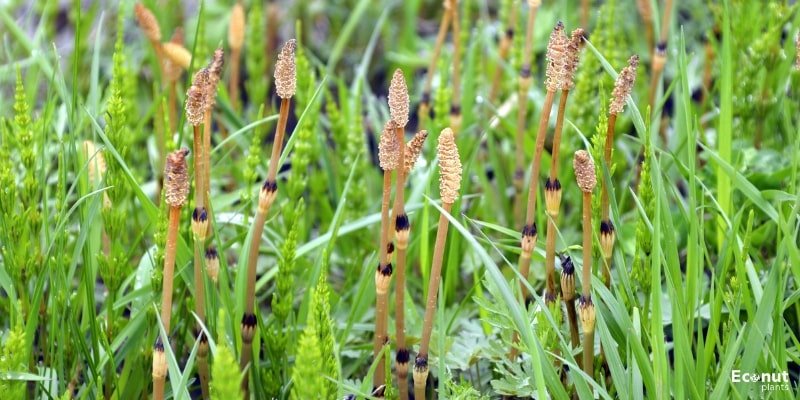
Scientific name: Erigeron Canadensis
An annual weed with upright growth is called marestail, or horseweed. Its solitary central stem, from which leaves sprout to form a bushy “tail” that can reach heights of seven feet, is where it gets its name.
In late April, this plant produces many blossoms on its upper branches. Thousands of tiny seeds are hidden inside the tiny white blossoms of this plant, and they will scatter after the season ends.
Over half of horseweed plants survive the winter, even though many of them perish after releasing their seeds. In contrast to certain other weeds, which can live for dozens of years, seeds often grow rapidly.
Marestail prefers soil that drains well and is gritty. The soil should ideally have a high organic content or be loamy. It can tolerate drought even though it prefers a fair amount of water. The flowers of marestail grow in USDA zones 3 through 11.
16. Oxalis
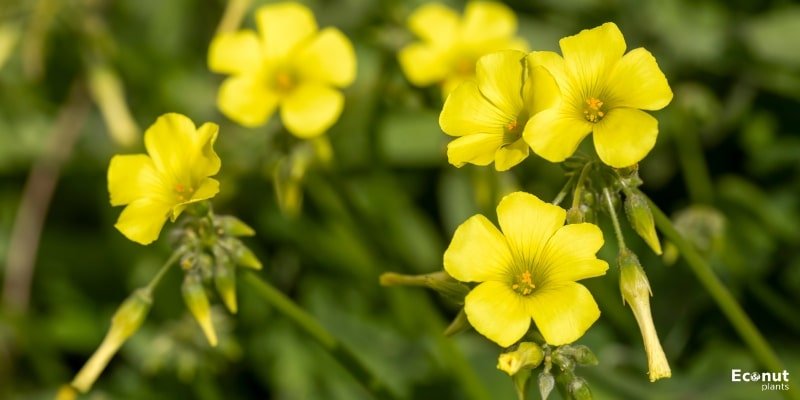
Scientific name: Corniculata
The weed oxalis has beautiful flowers with five petals. The hues range from pink to red to yellow to white. Oxalises feature many stripes extending from the center to the tips of their petals, regardless of the colour of the bases.
It has three to ten or more leaflets that cling to a woody stalk and resemble clover leaves. Because oxalises are light-sensitive, they may change the angle of their leaves to avoid receiving too much sunshine.
Oxalises leaves might be maroon in colour or a deep shamrock green. Because it tends to spread quickly, some people use this weed for decoration; nonetheless, it is recommended to plant it.
Oxalises prefer organic, well-draining soil with some shade. During the summer, they will lose their leaves if it gets too hot. USDA zones 7–10 are ideal for the growth of these weeds.
17. Purslane
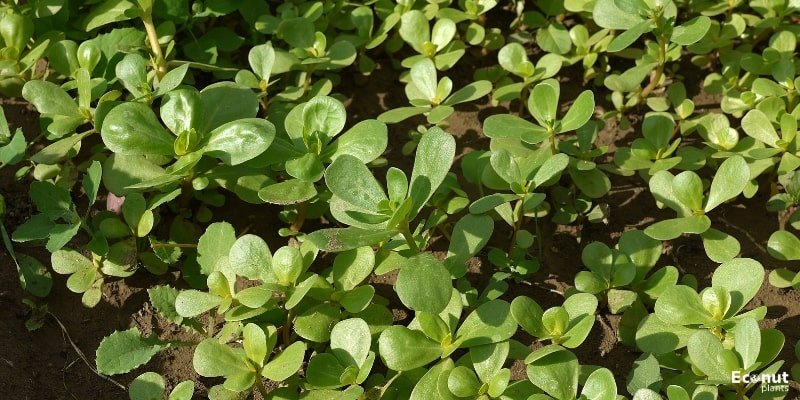
Scientific name: Portulaca oleracea
An annual herbaceous weed with succulent leaves and stalks is called purslane. This ubiquitous weed is frequently encountered in gardens and on lawns. Purslane resembles dandelions in appearance, but it may be distinguished by its oval-shaped leaves, which are broadest near the rounded tip. Attached to their purplish-green stems are the leaves.
Using hand tools like hoes or trowels to pull out all exposed roots is the most effective method of getting rid of purslane instead of using pesticides. Once you have formed a colony, purslane will expand quickly, so don’t let it go to seed.
18. Wild Violets

Scientific name: Viola odorata
Similar to wild roses, wild violets are the ungrafted, native form of the violet that most people cultivate in their gardens. Since wild violets grow swiftly and disperse their seeds quickly, many homeowners and gardeners consider them to be weeds.
The majority of wild violets feature purple blooms with fuzzy white centers. On the other hand, the outside of some of these blossoms might be white or yellow.
Along streambanks and in wooded regions, wild violets thrive. They prefer wetness but not standing water, as well as rich organic soil. Wild violets will shed their blooms to survive if they are planted in an area with lots of sunlight. In USDA zones 3 through 9, these weeds thrive.
19. Dandelions

Scientific name: Taraxacum
On this list, dandelions are arguably the most iconic example of a weed with flowers. A flower head of vivid yellow ray florets is present in them. The remaining petals face upward, but the outer bracts point downward.
Flowers are produced by dandelion plants from March to September. Then, when fall draws near, its petals fall, revealing spherical seeds carried by the wind.
Dandelions have a lot of uses, which may surprise the ordinary gardener. Some of them include making glue out of the white liquid found in the stems of dandelions and eating the infant leaves in salads.
Dandelions love to grow on cultivated, disturbed soil that receives plenty of sunlight. When they are not in the way of lawnmowers and thrive in soil with a pH between 3 and 9, they can reach a height of 28 inches. USDA zones 3–9 are where dandelions grow.
20. Black Medic
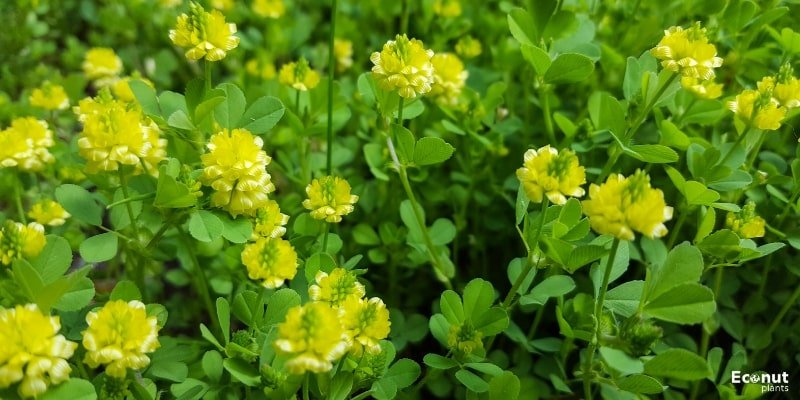
Scientific name: Medicago lupulina
Black medic’s heart-shaped leaves, which grow in clusters of three, may initially lead you to believe it is a clover. The most obvious distinction is that, as opposed to white blooms, black medic is a plant with yellow blossoms.
Each cluster of leaves produces an upright stem in the summer, and tiny yellow flowers that together resemble pom-poms start to bloom.
Black medic grows best in areas with compacted soil, such as garden paths and roadside ditches. Its lack of demand for a lot of organic matter indicates that your soil may need to be amended if you have it in your garden.
The plant likes acidic or neutral soil, as well as full or partial sun. From mountainsides to coastlines, it can withstand the weather. Within USDA zones 3a through 9a, black medic can grow in a variety of climates.
21. Chicory

Scientific name: Chicorium intybus
The attractive periwinkle-coloured blossoms of the chicory plant, which grows upright and straggly, take over many roadsides in the summer. Till the initial frost, the blossoms are still present. Along a sturdy branch, they grow to a diameter of about 1.5 inches and form groups of one to five.
Chicory blossoms are fleeting, with a single day of bloom. In addition, the flowers will remain open all day if they are in a colder environment. They will only come out in the morning in hotter climates, though.
It’s interesting to note that chicory is difficult to locate in unspoiled natural environments. Rather, it favours the terrain that has been disturbed by highways, wastelands, and pastures.
The ideal temperature range for chicory is 45 to 75 degrees Fahrenheit. It prefers soil that drains well, but excellent ground is not a must. USDA zones 3–9 are where chicory grows.
22. Common Evening Primrose
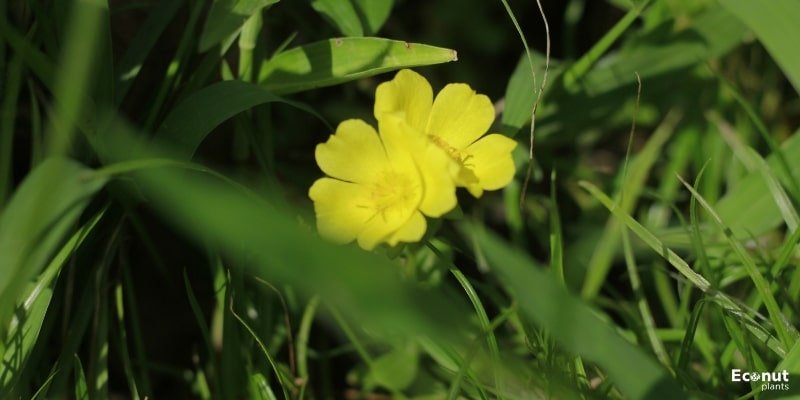
Scientific name: Oenothera biennis
The lovely yellow blossoms of the common evening primrose, which have a delightful lemon scent, have led to much controversy regarding whether or not it is a weed. Having said that, you’ll need to be a night owl to appreciate the blooms for longer because they open in the evening and close by midday.
Each two-inch-diameter flower of the common evening primrose has four petals. With long, thin leaves emerging from a basal rosette, the huge plant can reach a height of six feet.
Unlike many weeds, the common evening primrose flower is only in its second year of existence; hence, it takes two years for it to complete its life cycle. Sandier, stonier soils are preferred by evening primroses for growth. It is tolerant of sun or shade; however, it is best served by moderate rainfall combined with dry soil moisture. USDA zones 4–9 are where it grows.
23. Fleabane

Scientific name: Erigeron sp.
Given that they resemble little daisies, some refer to fleabanes as the eastern daisy fleabane. Little inner disc florets are affixed to a yellow center, while white florets cover the outside layer. In addition to their summer bloom, the flowers could also have a fall bloom.
There is typically one flower affixed to each of the fleabane’s several stalks on its stem. Small, delicate hairs cling to these stalks.
With sufficient time and support, the fibrous roots of fleabanes can develop into taproots. It likes bright, airy spaces. That being said, poor-quality soil is typically where it finds the least competition. In soil that varies from acidic to alkaline, fleabanes are present. USDA zones 5 through 9 are where they grow.
24. Groundsel
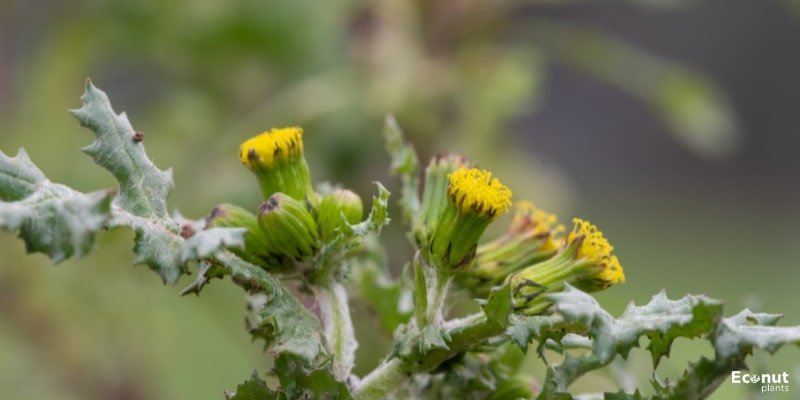
Scientific name: Senecio vulgaris
Small yellow flowers that open for the majority of the year are produced by groundsels. They lose their petals and become fluffy and white, resembling dandelion seeds as they get ready to plant.
When viewed up close, the groundsel’s blooms, which appear to be separate entities from a distance, really have a composite head made up of numerous tiny flowers grouped.
The harsh, inoffensive teeth on the alternate leaves of the up to eighteen-inch-tall groundsel spear the foliage into lobes. Secondary fibrous roots support a taproot that grows near the surface, keeping it in place.
It’s not uncommon to see groundsel growing in cement cracks, beside roadways, and around landfills. It prefers dirt, but it may thrive in almost any type of soil. USDA zones 3–9 are where groundsels grow.
25. Jimsonweed

Scientific name: Datura stramonium
Jimsonweed, a member of the nightshade family, has forked branches and fragrant trumpet-shaped flowers on each one. Its petals are coloured in shades of white, cream, and violet. The flowers of this weed open at night, which may not come as a surprise to anybody familiar with nightshades.
Jimsonweed grows in almost every warm-weathered region of the world, including meadows overflowing with excrement and roadsides. It grows well around landfills as well.
Even though jimsonweed is consumed for its intoxicating effects, it is dangerous. Before flowering, when the toxin content is highest, it becomes comparatively harmless.
Jimsonweed grows well in sunny or partially shady settings. Although it can thrive in most types of soil, including clay, loam, and calcareous soil, it loves dry soil. In USDA zones 6 through 9, jimsonweed grows.
26. Milkweed
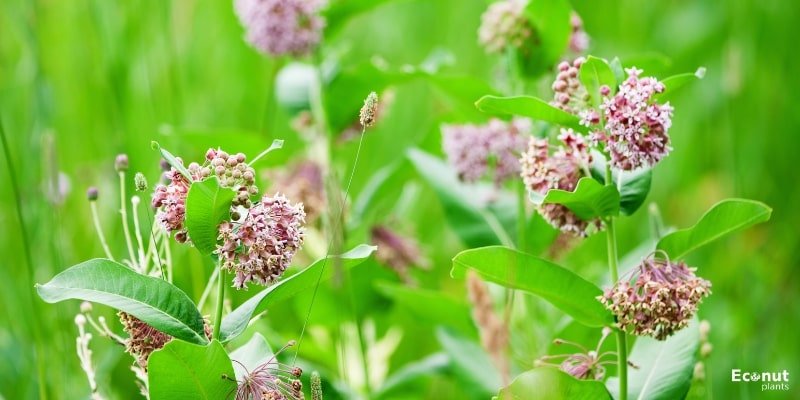
Scientific name: Asclepias sp.
When you snap the stem of milkweed, a sticky white substance resembling milk is released, as any youngster who grew up in a rural area would know. This plant has a strong fragrance that draws a wide variety of insects for pollination and feeding.
Milkweed blooms in a variety of hues, such as orange, pink, purple, and green. Its 2–5-foot stem is topped with a large cluster of small blooms that give it a ball-like look.
Monarch butterflies love to lay their eggs beneath it because of its big, green foliage. The plant’s leaf provides food for the larvae once they hatch.
Milkweed can withstand most soil types and is particularly happy in bright sunlight. Nevertheless, other species, like swamp milkweed, require moist, rich soil to thrive. USDA zones 3–9 are where milkweed grows.
27. Queen Anne’s lace

Scientific name: Daucus carota
Queen Anne’s lace is a weed that bears true to its name: it has densely clustered white flowers that resemble lace since there are tiny gaps in between them. In their second year, Queen Anne’s lace will begin to produce these flowers if you leave them unattended.
In addition, Queen Anne’s lace is tall, reaching up to four feet in the air to wave its flat-topped blossoms. Its leaves, which resemble the long, narrow leaves of ferns, also offer a pleasing appearance for weeds.
Queen Anne’s lace spreads rapidly when it is sown in open spaces. It is happy to grow in sunny areas, such as fields.
While this plant may grow almost anywhere, it is most happy in neutral or alkaline soil that drains well. In USDA zones 3 through 9, Queen Anne’s lace grows.
28. Smartweed

Scientific name: Polygonum sp.
If you don’t mind where it grows, smartweed is a lovely weed with a sequence of pinkish-white blooms that closely stack on top of one another, trailing the upper 1.5 inches of its stalk. These flowers resemble petals because they feature sepals in place of petals.
The smartweed you come upon should grow up to six feet tall, though as it gets bigger, the flowers and leaves may begin to droop under their weight. They are not the same as knotweeds, which resemble them but have flowers grouped around the axils of their leaves.
Flowers are produced by the smartweed from June through November. When a sepal opens, its inner side often turns whiter, while the outer side is typically a richer pink colour.
Smartweed thrives in moist environments, such as ditches, wetlands, and streambeds. They thrive in USDA zones 3a through 10b and prefer rich soil.
29. Wild Clovers

Scientific name: Trifolium repens
Famous for their pom-pom-like, purplish-white flowers, wild clovers bloom in grassy places on solitary stalks. It can reach a height of 40 centimeters, and from May to October, you can see it blooming.
The wild clover may make you reconsider keeping the majority of the weeds on this list in your garden. Because of its high nitrogen content, it enhances the quality of the local soil where it grows.
In regions that are prone to drought, wild clovers are frequently observed since they require little water to thrive. They also tolerate full sun and moderate shade well, which is why they occasionally overpower other weeds.
To the dismay of a gardener, wild clovers can grow in almost any sort of soil and keep up well even when tramped. USDA zones 3–10 are where it grows.
30. Nettle
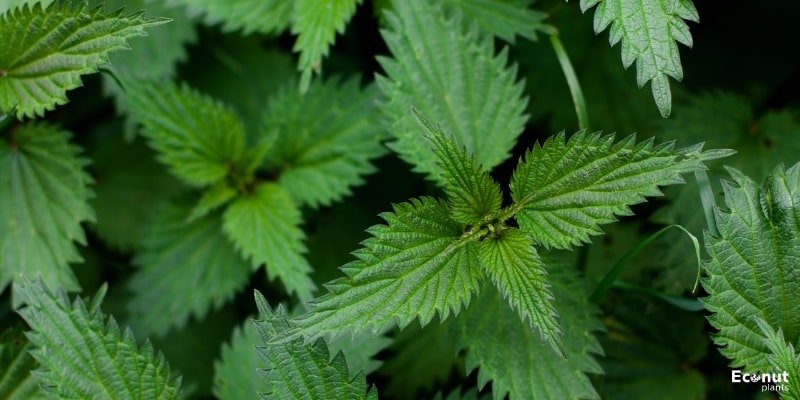
Scientific name: Urtica dioica
Nettles are perennial flowers; however, they may not be immediately apparent. The flowers are small and range in colour from green to brown. Along the entire length of the stalk, the blooms stay in bunches.
There are a lot of tiny hairs on nettle leaves. This specific species isn’t toxic, but some have toxins in their hair that, if they break off and sting you, can cause excruciating pain. Getting stung by nettles can be terrible in any scenario.
High-nitrogen soil is necessary for nettles. They favour slightly shaded, well-aerated soil that has a pH between 5.0 and 8.0.
Nettle is often found along pastures and field borders, where it can pose a problem for cattle. USDA zones 3–10 are where nettles grow.
31. Black Nightshade

Scientific name: Solanum nigrum
Due to the presence of the toxin solanine, the name “black nightshade” may give you chills. Consuming it by people or pets is not recommended. The white blooms of black nightshades, which begin to blossom in late spring, qualify them for inclusion on this list of weeds with flowers.
Growing around two feet high and one foot broad, they continue to produce flowers until September. Any plant with male and female parts is a hermaphrodite. So, to pollinate their flowers, they rely on insects.
The tolerance of black nightshades to less-than-ideal growing circumstances is high. They thrive on soil that is clay, loamy, and sandy. Nevertheless, they require plenty of sunlight and proper drainage wherever they are grown. USDA zones 10a through 11 are where black nightshades grow.
32. Common Self-Heal
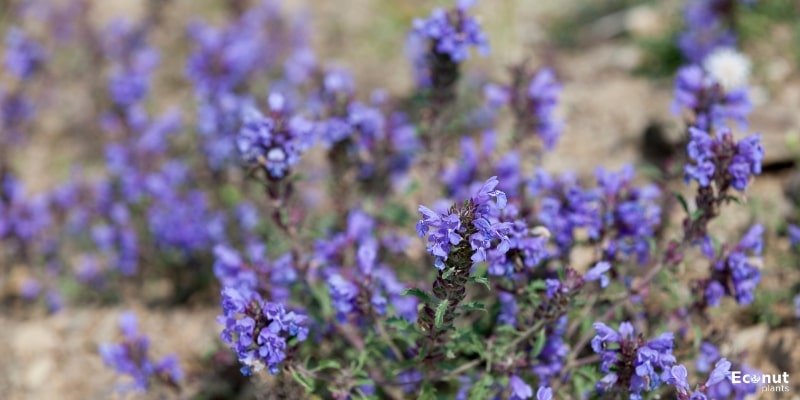
Scientific name: Prunella vulgaris
The common self-healing plant entwined with grass is “common.” It produces magnificent violet, pink, or white flowers from June to September. The petals of these towering blooms grow from a single center.
The seeds of common self-heal begin to ripen in August. Given that they thrive on clay, sandy, and loamy soils with mild acidity to mild alkalinity, they have a good chance of surviving.
One of the more difficult weeds to eradicate in gardens with flowers is common self-heal, which requires room to spread out where it can receive both full and partial shade, or along the roads that wind through your garden.
It prefers well-draining soil that is kept damp, and it stays out of the shadow provided by larger plants. USDA zones 3 through 7 are where common self-heal grows.
33. Creeping Buttercups

Scientific name: Ranunculus repens
The yellow, glossy petals are characteristic of the creeping buttercup. Its flowers contain five petals on average, but occasionally ten. With a single blossom atop each petiole, they arise from slender stalks.
Buttercups that creep appear in March through August. Despite their quick growth rate, they can be an appealing plant to cover ditches on rural roads. In a year, a single plant can cover an area larger than 40 square feet.
Buttercups that creep like damp places. Common locations for this plant to be found are fields, swampy places, and well-irrigated lawns. To make matters worse, animals that eat it are poisoned.
The creeping buttercup’s capacity to survive in healthy soil is one of its most recognizable characteristics. It can wait 80 years to germinate in environments that are either water-saturated or acidic. USDA zones 3 through 8 are where creeping buttercups grow.
34. Henbit

Scientific name: Lamium amplexicaule
Henbit is an herb as well as a weed because its leaves stem, and blossoms may all be used in tea. Despite being a member of the mint family, this plant tastes more like kale.
In the highest circular portions of their leaf axils, henbits bear tiny, elongated, deep pink blooms. Their appearance is similar to that of an orchid, with a white face and sparkles of red. Even still, this plant is considered a weed because of how quickly it spreads and how it forms roots from its ground-touching stalks.
Henbits are known for having leaves that resemble wrinkles due to the recessed upper veins. Despite having a sturdy stem, the plant only reaches a height of 30 centimeters.
Dry, well-tilled soil is preferred by henbits. As a result, it thrives in gardens and fields; however, waste places are also home to it. Plant henbits in USDA zones 4 through 8.
35. Lesser Celandine

Scientific name: Ficaria Verna
The family of buttercups includes lesser celandine. It is so star-shaped and has glossy yellow petals. Every flower has eight to twelve petals. Additionally glossy and shaped like a heart, the leaves of this plant are held aloft by lengthy stalks.
Lesser celandine grows low and blossoms from January to April, but its lush greens first emerge in the autumn and winter. It can be found in meadows, forests, and gardens. For this weed, damp locations are essential. Thus, it gathers by ditches and stream sides as well.
Lesser celandine has particular growth requirements, unlike many other weeds. It needs basic to alkaline soil, shade, and poor soil conditions to thrive.
Because of its underground runners and tubers, lesser celandine grows quickly. As such, it spreads quickly to overrun garden borders and the shady spots your plants create. USDA zones 4 through 8 are where lesser celandine thrives.
36. Creeping Speedwell

Scientific name: Veronica filiformis
Some people use creeping speedwell as an attractive groundcover because of its white and bluish-purple flowers, which bloom from April to July. It might be an issue if you’re attempting to maintain a tidy appearance because it grows particularly effectively in the spaces between rocks.
Although a single creeping speedwell plant can extend up to 29 inches, it only reaches a height of 2 to 3 inches. Its leaves can range in colour from pale green to grey-green based on how much sunlight they get.
Loamy or sandy soils with lots of water and a neutral pH are preferred by creeping speedwells. They are rapidly expanding and recovering from moderate foot traffic.
USDA zones 4 through 8 are where creeping speedwells grow, though they can tolerate zone 9 if it has access to some shade.
37. Herb Robert
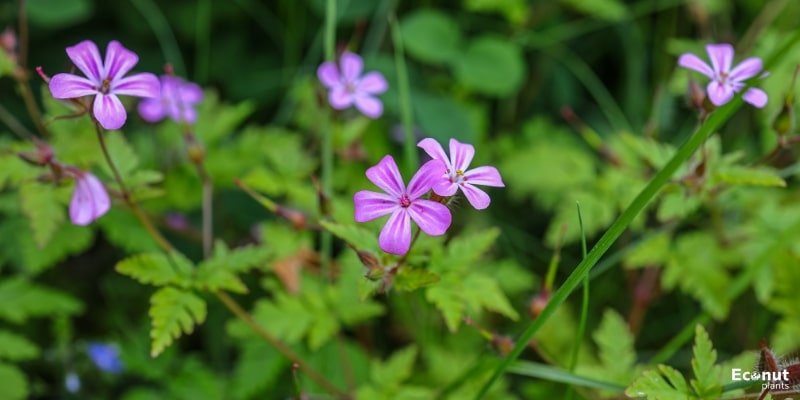
Scientific name: Geranium robertianum
In the spring and summer, Herb Robert grows brilliant pink blossoms in forested places. It has naturally green stems and leaves. On the other hand, this plant gets red and gets black patches if it gets too much sun.
Herb Robert, as its name suggests, is more than just a plant; people use it as an insect deterrent and disinfectant. This plant is generally hardy and can outlive many other nearby plants, even though fungi can occasionally be a problem.
Herb Roberts can reach a height of 20 inches in wet, dimly lit environments. They commonly grow between rock fissures and provide little crimson fruits.
These plants will not survive long in damp conditions; they do best in soil that is high in nitrogen. USDA zones 5–9 are where Herb Robert grows.
38. Meadow Death Camas
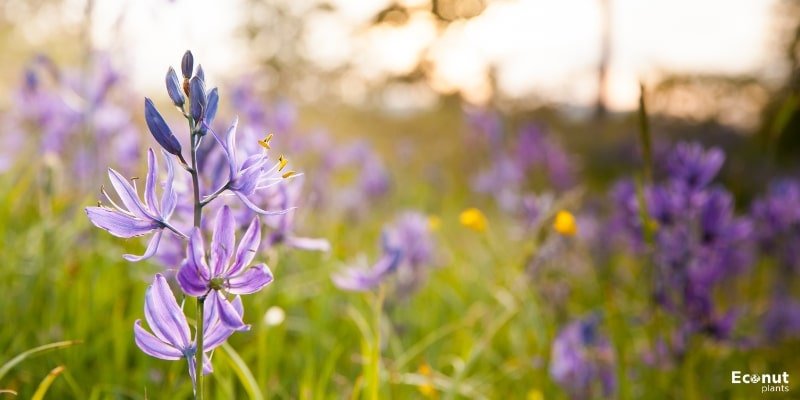
Scientific name: Zygadenus venenosus
Among the toxic weeds with flowers we’re discussing today is meadow death camas. At the top of their stalks, several tiny flowers make a triangular-shaped head, and they feature pretty white flowers with yellow centers.
Long stamens contribute to the beautiful design of meadow death camas. Their foliage is grass-like and grows in an upward V-shape from the ground. They bloom from April to July. Hence, it’s easy to confuse them for fast-growing grass when they’re not in flower.
Meadow death cama grows primarily in arid regions. They thrive in meadows with low rainfall, sagebrush slopes, and hillsides.
The mining bee is the only insect known to be able to pollinate meadow death camas due to its poisons. In USDA zones 8a through 11a, it grows.
39. Silverbush

Scientific name: Convolvulus cneorum
The trumpet-shaped white flowers of field bindweed have pink buds before they open. These flowering weeds bloom in the spring and continue into the summer. Since field bindweeds are native to the Mediterranean, they enjoy hot, dry summers. Additionally, that’s when they produce the most seeds.
Field bindweeds are exceptionally drought-tolerant due to their complex root structure. Additionally, they can thrive in cultivated or densely populated areas.
However, rich, well-draining soil is good for them. These weeds are frequently observed growing in meadows and by the sides of roadways.
The evergreen shrub, known as field bindweed, can reach a height of three feet or more. It does well in USDA zones 8a through 10b.
40. Common St. John’s Wort
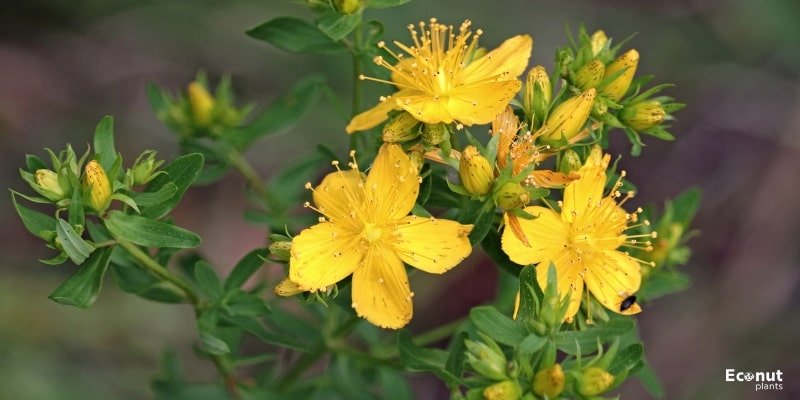
Scientific name: Hypericum perforatum
The common St. John’s wort, a native of Europe, is well-known due to its antidepressant qualities. It has deep yellow flowers with brighter yellow centers around which protrude dozens of stamens.
A balance between shade and sun is necessary for the best flower production of common St. John’s wort. Too little sun will cause it to produce fewer flowers, while too much sun will cause leaf scorch to develop.
St. John’s Wort can thrive in almost any type of soil, including loam and stony ones. It can withstand acidic to somewhat alkaline earths in terms of pH.
You’ll probably see Common St. John’s wort around if you live in a region that floods occasionally since it holds up well. USDA zones 5 through 10 are ideal for common St. John’s wort growth.
41. Herb Bennet

Scientific name: Geum urbanum
Small yellow flowers are produced by the herb bennet between May and August. The five-petalled flowers soon droop after opening. Here are prickly seed heads. They cling to passing humans and animals thanks to the red hooks on their ends.
Herb Bennets are undoubtedly among the weeds with flowers that you should avoid having close by. On the other hand, some season soups use the herb Bennet roots and leaves.
Because they frequently inhabit woodlands, hedgebanks, and scrub, these weeds prefer shaded spots. To flourish, they also need well-draining soil that is rich in nutrients and a reasonable quantity of water. Herb bennets can tolerate almost any pH range of soil and are self-fertile. These plants are in USDA zones 5–9.
Conclusion
A weed to one person might be a gem to another. Ultimately, someone was wise enough to transform wild violets and roses into the elegant flowers we see in our gardens today.
Now that you know how to recognize common weeds with flowers, the initiative is in your hands. It makes sense to get rid of any dangerous weeds that are growing on your land.
However, you might want to start referring to the pretty flowers on innocuous weeds in your backyard as “plants” rather than “weeds,” if you like that.

